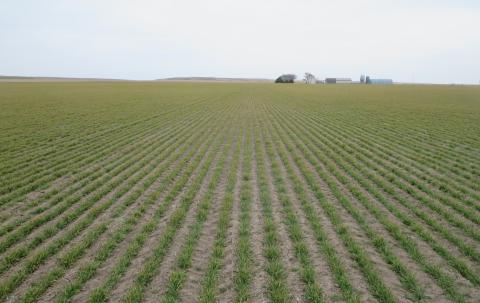Double Cropping Pulses with Short-Season Crops, Forages, and Cover Crops in Eastern Nebraska
September 6, 2018
A research project in eastern Nebraska is evaluating a double crop production system as a potential alternative to the traditional corn/soybean rotation. Following an early season crop of yellow field peas, short-season crops (corn, soybean, grain sorghum, millet and sunflower) and annual forages (forage sorghum and sorghum-Sudangrass) were planted.
CoAXium™ Wheat Production System and Aggressor™ Herbicide for Controlling Grassy Weeds
August 30, 2018
A new herbicide-tolerant wheat production system was officially unveiled in 2018 and offers growers a new means to control grassy annual weeds in wheat.
Wheat Seeding Date Impacts Yield
August 29, 2018
Wheat seeding date affects multiple factors contributing to wheat yield. While there's no perfect date for all conditions, these recommended dates have been proven and verified.
Fall Strategies for Weed Control in Winter Wheat
August 29, 2018
Managing weeds at least two weeks prior to planting winter wheat and then controlling winter annuals this fall are important to reducing disease, saving soil moisture, and achieving top yields next summer.
Cultural Management Options for Wheat Stem Sawfly
June 7, 2018
Sawfly management in wheat requires a diversified approach using a number of tools. Growers who know which fields have greater levels of infestation can help manage the effects of sawfly this year as well as next year. Fields with high infestations should be harvested first, if possible.
Winter Wheat Progress Across the State
April 26, 2018
Winter wheat in the Nebraska Panhandle continues to be rated above average with most of the wheat rated good to excellent. Winter wheat in the west central, south central, and eastern areas is more varied, as described in this wheat progress and condition report.
Winter Wheat Nitrogen Applications
April 25, 2018
Spring is the ideal time to apply nitrogen (N) to winter wheat to ensure top yields. Adequate N levels promote tillering, large head size, and are the primary factor determining the protein level of the grain at harvest. There are a few things to consider to optimize N applied to wheat.
Field Peas—A Guide to Herbicide Carryover And Herbicide Efficacy
February 22, 2018
How to avoid herbicide carryover injury when designing an effective herbicide program for crop rotations integrating field peas.









